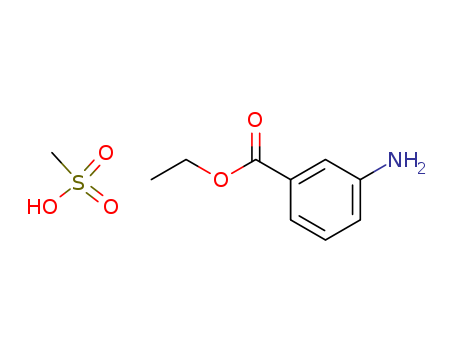Your Location:Home >Products >Intermediates >886-86-2


Product Details
|
Uses |
A benzocaine isomer derivative. |
|
Definition |
ChEBI: A methanesulfonate salt obtained by reaction of tricaine with one molar equivalent of methanesulfonic acid. Used as an anaesthetic for fish. |
|
General Description |
Ethyl 3-aminobenzoate methanesulfonate is mainly used as an anesthetic for fish. It is also used for the euthanasia of all fish species especially zebrafish, which is commonly used in research. |
|
Biological Activity |
ethyl 3-aminobenzoate can block the generation of action potentials via voltage-dependent na+-channels.sodium channels play a critical role in physiology: they can rapidly transmit depolarizing impulses throughout cells and cell networks, therefore enabling co-ordination of higher processes. sodium channels are also of special importance for the history of physiology. |
|
in vitro |
the major mode of action for ethyl 3-aminobenzoate was found to be nervous system suppression whereby the entrance of sodium into the nerve was inhibited, therefore limiting nerve membrane excitability. in addition, the nerve inhibition was facilitated by the lipid solubility of ethyl 3-aminobenzoate, which allowed it to move easily into the cell membrane to bind with sodium channels [1]. |
|
in vivo |
previous study evaluated the potency and dynamics of ethyl 3-aminobenzoate-induced effects on neuronal firing of sensory and motor nerves alongside a defined motor behavior in xenopus laevis tadpoles. electrophysiological recordings of extraocular motor discharge and nerve activity were measured before, during and after administration of drugs. results showed that ethyl 3-aminobenzoate and benzocaine, but not pancuronium could cause a dose-dependent, reversible blockade of extraocular motor and sensory nerve activity. such results indicated that ethyl 3-aminobenzoate was able to block the activity of both sensory and motor nerves compatible with the mechanistic action of effective anesthetics, suggesting that ethyl 3-aminobenzoate was effective as single-drug anesthetic for surgical interventions in anamniotes [2]. |
|
references |
[1] k. m. carter, c. m. woodley and r. s. brown. a review of tricaine methanesulfonate for anesthesia of fish. rev. fish biol. fisheries 21, 51-59 (2011). [2] c. ramlochansingh, f. branoner, b. p. chagnaud, et al. efficacy of tricaine methanesulfonate (ms-222) as an anesthetic agent for blocking sensory-motor responses in xenopus laevis tadpoles. plos one 9(7), e101606 (2014). |
InChI:InChI=1/C9H11NO2.CH4O3S/c1-2-12-9(11)7-4-3-5-8(10)6-7;1-5(2,3)4/h3-6H,2,10H2,1H3;1H3,(H,2,3,4)
CAS:30827-99-7
CAS:573762-62-6
CAS:18871-66-4